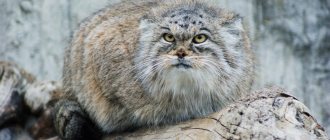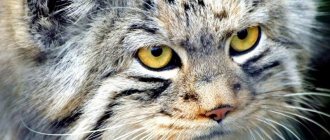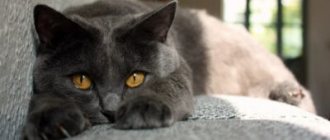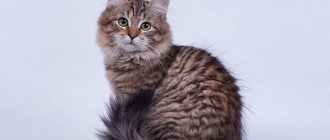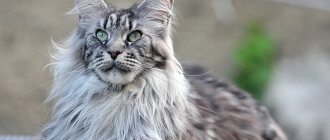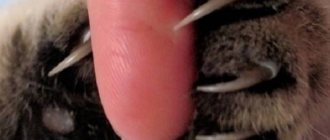Manul is the most cautious and slow representative of the cat family. It is also called the “Pallas cat”: a naturalist named Pallas first encountered the animal back in the 18th century. The attractive appearance and calm nature aroused the desire to domesticate the animal among many lovers of exotic pets. This is feasible, but there are some nuances: a cat is still better suited for living in the wild.
Homemade manul
Keeping Pallas's cat at home
Does the concept of homemade manul exist? Is it possible to keep a representative of this breed at home? Keeping a Pallas cat in your home is not the best idea.
And there are several objective reasons for this:
- It is impossible to legally acquire a wild cat in order to keep it at home, since this animal is listed in the Red Book;
- Wild Pallas cat kittens are often exposed to infectious diseases and die;
- Pallas cats are one of those species of wild cats that have not yet been fully studied by scientists. If an animal gets sick, it will be almost impossible to save it;
- Animals are distinguished by their indomitable temperament, unsociability and arrogant character, which can cause a lot of trouble;
- By keeping a wild cat at home, a person risks receiving considerable material damage: torn wallpaper and furniture, broken dishes and overturned flower pots, hairballs throughout the apartment or house. The Pallas's cat will not sit still quietly when living indoors;
- Pallas' cats have very aggressive behavior towards others. They will bite and scratch and may attack children and other pets. These animals will show aggression not only towards strangers, but also towards their owner.
Video
Sources
- https://kot-pes.com/manul-foto-svobodnyj-stepnoj-otshelnik-ili-milyj-domashnij-pitomec/https://animaljournal.ru/article/jivotnoe_manulhttps://koshkimau.ru/porody-koshek/ dikie/manul.htmlhttps://pipcat.ru/different/kot-manul.htmlhttps://ru.wikipedia.org/wiki/Manul
Interesting Facts
Some interesting facts about the Pallas cat:
- In 1996, the Tajikistan Post dedicated a series of 12 stamps to Pallas's cat. Postage stamps with cats were also issued in Azerbaijan, Mongolia, and Kyrgyzstan.
- The Pallas cat was included in the issues of UN and Benin stamps, which were dedicated to rare species of animals.
- In 1996, Turkmenistan issued a commemorative silver coin with a face value of 500 manat, on which the Pallas cat was displayed.
- In October 2012, the Pallas's cat was chosen as the mascot of the Moscow Zoo by electronic voting.
- In 2008, the “Pallas cat” meme appeared on the RuNet in the form of images of a cat with the caption “Pet the cat.”
- In 2016, the Bank of Russia issued a silver coin with a face value of 2 rubles, dedicated to the Pallas cat from the “Red Book” series.
- Pallas' cats are found in mountainous areas at an altitude of 3000-4800 m.
- Dense fur and short legs make it difficult for a cat to move, so a fast-running Pallas' cat is a rare occurrence.
- When in danger, wild cats hide in the hope that no one will notice them. But if he is found, the attacker will not be happy. Manul fights desperately, not for life, but for death.
- Pallas' cats tolerate cold temperatures down to -50°C. They are protected by thick fur.
- Pallas' cats are loners by nature; they do not need the company of their relatives. The fathers of the offspring shift the responsibility for raising the kittens to the female, but in case of danger they will kill any offender.
- Each animal lives on an area of up to 10 km².
- Pallas' cats cannot meow, but they snort and growl great.
- Pallas' cats prefer to remain silent. Even kittens are silent so as not to attract the attention of enemies.
- Pallas's cat is an ancient creature. Scientists estimate its age at 12 million years. Thanks to their secluded lifestyle, their appearance has changed little.
Tamed manul
It is not for nothing that the Pallas cat is considered an exotic animal. It will not be possible to completely tame him. Therefore, even if you bought him as a small child, you should not count on him becoming a tame kitten. The instinctive isolation of the Pallas's cat from humans will be inherent in it even when kept at home.
And even if at a young age a kitten is still able to play with human hands, then after puberty this will no longer be possible, instincts will take over.
Increasingly, exotic animals are chosen as pets: lemurs, raccoons, salamanders, crocodiles, leopard geckos, snails, iguanas, chameleons, squirrels, jerboas.
Conditions for keeping
Of course, the best place to keep such a pet would be a private yard. The cat can withstand low temperatures, and the open space, trees and bushes will remind him of his natural habitat. In addition, in the yard it will be more comfortable for him to lead a nocturnal lifestyle and not disturb the owners.
He is absolutely not suitable for keeping in an apartment, since it is unlikely that it will be possible to provide him with conditions where he can hide and where he will not cause inconvenience when he goes out hunting at night. In addition, you must always remember that entering its territory is taboo for a person; he risks getting bitten and scratched.
Important! Despite its slowness, the wild cat has lightning-fast reactions and can attack an enemy without warning. His dissatisfaction will not be revealed by any external manifestations, because his muzzle always has an angry and wary expression.
Breed care
Like any wild animal, the manul is capable of caring for itself. It is unlikely that you will be able to accustom him to forced water procedures. The only thing you can try in terms of grooming is combing out the animal’s fur, which is almost constantly in a state of shedding. Owners of Pallas cats in their apartments feel this well, finding clumps of cat hair throughout their home every day.
What to feed a wild cat
What to feed the animal is one of the first questions that a person who is planning to get a Pallas's cat should ask himself.
In the wild, this feline feeds on the Daurian pika and small rodents. As a rule, it watches for them, hiding near their holes. It can also hunt hares, marmots, and birds. If food is tight, it eats insects.
Whether you can provide your pet with such food is up to you to decide. After all, there are big doubts that a wild animal will want to eat dry cat food or canned food. At the zoo they are fed meat and rodents.
Did you know? Manul was first discovered in the 18th century by naturalist Peter Simon on the shores of the Caspian Sea. It was named Otocolobus, meaning "ugly ear".
Health and common diseases
An adult carpet cat has excellent health and rarely gets sick if it lives in its habitat. Changes in the usual way of life and climate negatively affect the physical and emotional state of animals. Even when kept as Pallas' cat cats in the zoo, they rarely live to a ripe old age.
Despite successful breeding in zoos, most of the cubs die from toxoplasmosis. Adults are also susceptible to this dangerous disease. Treatment of animals is very problematic; sick cats do not allow people to approach them, behave extremely aggressively, try to grab a hand or throat, which is fraught with very serious consequences, because their teeth are sharp and their jaws are strong.
Homemade Pallas's cat: is it possible?
Manul is the only wild feline that is practically no different in size from domestic cats. And also prefers to hunt rodents and birds.
But why, seemingly very similar to a domestic cat, cannot take his place? And there are important reasons for this:
- The manul is a sole farmer who does not want to share his territory with anyone. All uninvited guests are mercilessly expelled, which means that eternal fights with the neighbor's cats are guaranteed.
- While still a kitten, the Pallas's cat begins to hunt. Babies receive their first lesson in the wild after they are only three months old.
At the same time, Pallas' cats can be found in many zoos, where they feel great. But keeping them in captivity undermines the immunity of cats. And so that the kittens do not die, primary vaccination of cats is mandatory, providing the necessary protection. In addition, until the babies turn three months old, the animals receive additional vaccinations against all infectious diseases every two weeks. And, of course, mandatory annual vaccination is carried out.
Family life of Pallas's cat
Pallas cat kittens appear only once a year. As a rule, a litter consists of 2….6 cubs. The mating season, as befits cats, begins in February – March. The “March” fights for the opportunity to own a female look impressive. Of course, timely castration of the cat would completely solve the problem of the domestic cat, but small predators appear regularly in zoos.
Pallas' cat mothers are very attached to their babies and care for their kittens very carefully. If it is necessary to protect the cub, the female is capable of attacking an enemy even larger than her. But at the same time, the mother does not hesitate to give her offspring a beating.
Hand cat: myth or reality?
Not a single attempt to domesticate Pallas' cats has yet succeeded. Being a small kitten, the animal can still be restrained somehow. But the baby is growing and the hunting instinct awakens. And now the cute cat is actively attacking everyone who, in his opinion, is encroaching on his territory. There is only one way out of this situation - transferring the baby to the zoo and under no circumstances euthanasia. After all, cats are euthanized only in cases where they are terminally ill. All other reasons are unjustified cruelty. It is not the predator’s fault that nature created it this way, capable of living exclusively in freedom.
House for manul
Pallas' cats prefer to choose hard-to-reach places for their den, for example, crevices among rocks or stones. Very often, the predator uses abandoned dwellings of foxes, tarbagans, badgers and corsacs as a hole. This is another one of the list of reasons why the Pallas cat cannot live in the house. It is completely unrealistic to recreate such conditions in a city apartment.
Lifestyle
Wild cats lead a solitary, sedentary lifestyle. They prefer to settle in rocky areas (hence another name - cave cat). Pallas' cats make dens in stone crevices; with their sharp claws they can dig a hole for their own housing. The animals carefully guard their home and drive away any stranger who looks there.
The love for rocky terrain and cold winters with little snow determine the range of animals: Tibet, Western China, Transbaikalia, Mongolia, Afghanistan.
Pallas' cats prefer a nocturnal lifestyle: they hunt only in the dark.
Pallas cats are considered the first cats to appear in the world.
The prey of wild cats are mice, small hares, small birds, and marmots. Nature has not blessed cats with quickness, so they can wait for hours for future food near their holes. In summer, insects and plants are added to the diet. All because of the same slowness, manulas themselves become the subject of hunting by larger predators. These felines cannot escape; when in danger, they hide or climb a tree.
In mating games, Pallas' cats do not differ from their domestic relatives: several males fight for the location of one female and start fights.
Pallas's cat in the wild
The predilection for loneliness makes it difficult for wild cats to reproduce: it is difficult for them to find a mate. By the way, this is one of the reasons why Pallas' cats are constantly on the verge of extinction. Other factors contributing to the population decline: poaching, the risk of falling into a trap set for other animals, eating small rodents poisoned by chemicals, and death in forest fires.
There are usually 2-6 kittens in a litter; in the first 2 months of life they are helpless; only the female cares for the cubs. Growing up, babies begin to leave the shelter, adopt the hunting habits of their mother, and reach full independence by 8 months.
In captivity, animals reproduce poorly, even in a zoo. Employees note that captured females who grew up in the wild experience pregnancy more easily and raise offspring safely. Of all the kittens born in captivity, no more than half survive.
Manul with kittens
Like other predators, Pallas cats have acute vision and hearing.
Interesting facts about Pallas' cat
Maine Coon kitten size
Maine raccoon cats are born quite large in size and weigh an order of magnitude more than kittens of other breeds. For example, if the weight of a newborn Persian breed varies between 125-150 g, then a Maine Coon kitten is born weighing 125-170 g. According to average statistical data, the weight of a newborn Maine Coon is significantly influenced by the number of kittens in the litter, therefore , the fewer kittens, the greater their weight.
The rate of growth processes and weight gain in a newborn directly depends on its gender, as well as the characteristics of the parental genotype. As a rule, kittens born from a physically healthy and massive cat grow and develop faster. The kitten's growth can be negatively affected by the cat's use of hormonal drugs that can provoke a pronounced endocrine imbalance.
In order for a Maine Coon kitten to gain height and weight correctly, it is necessary to comply with a number of requirements, including ensuring optimal sanitary and hygienic conditions in the place where the animals live, preventing stressful situations in the form of noise and temperature changes, and proper and balanced nutrition for the nursing cat and kittens.
The suckling period lasts from birth until four weeks, and is also characterized by constant and stable growth. In the first ten days, the kitten’s body weight doubles, and by a month the weight becomes approximately four times greater.
Content issues
There are only a few known cases when Manul behaved adequately at home. Usually a wild animal does not accept its owner, so it secludes itself or causes a pogrom.
The complexity of the content lies not only in its behavior, but also in its physiological characteristics. The cat sheds a lot because an apartment is not his habitat. Eating problems may also arise. In the wild, the predator feeds on rodents and small mammals, obtaining a sufficient amount of useful substances naturally. In order for the patient to feel comfortable, it is necessary to create a balanced diet for him.
As for the continuation of offspring, it will be almost impossible to find a mate for such a rare pet, and they cannot be castrated or sterilized. In the spring, Manul will “demand” mating, and it is unknown how hormonal disruption will affect his behavior.
Most veterinarians will not be able to treat an exotic pet in case of illness due to insufficient qualifications.
Possible difficulties and illnesses
In the process of keeping Pallas's cat in captivity, problems may arise with treating the animal, since very few veterinarians are familiar with the characteristics and diseases of the species, and methods for domestic cats are not always applicable to it. In addition, the mustachioed-striped one simply will not let anyone near him, even at moments when he is unwell. Of the most dangerous infections that are typical for this furry animal, the most likely is toxoplasmosis.
Manul. A complete description of the animal and its way of life in the wild
The Pallas cat was first described by the German naturalist Peter Pallas when he met a cat in the Caspian steppes. As a result, the Pallas cat was given the second name Palasov cat.
The size of the Palas cat is comparable to the size of an ordinary domestic cat. The body length does not exceed 65 cm, the tail - 31 cm, and the weight of the Pallas's cat does not exceed 6 kg. It differs from the usual domestic “murka” only in its long thick hair, massive paws and unusual ears. Pallas' cat's ears are wide, rounded, placed on the sides of the head, from which tufts of long hair descend. The color of the coat varies depending on the habitat of the Pallas's cat. But in all the places where Pallas' cats live, their gray fur has white tips, resulting in the appearance of fur dusted with snow. 6-7 black stripes about 1 cm wide stretch across the back. The tail is gray, at the end black with seven transverse narrow stripes. Under the eyes, through the cheeks, there are two black stripes: one to the base of the ear, the other under the ear to the neck.
Wild cat manul
Unlike other small cats, the Pallas's cat lives in open places. These cats lead a solitary lifestyle and are active at dusk. Pallas's cat hunts mainly on mouse-like rodents. This is the slowest cat, it almost never catches up with its prey. After a hunt, the Pallas's cat likes to relax in its den; it is most often located among mountain gorges or in the burrows of other animals.
Only during the mating season does the Pallas' cat meet with females. After mating, the female brings kittens after 60 days of pregnancy. Babies appear in April or May. Most often, from two to six blind and helpless kittens are born in a litter, but it happens that up to 10 kittens are born in one litter, but more often there are 3 or 5 babies in a litter. The weight of a newborn Pallas's cat is about 70-250 grams and 12 cm in length. I begin to see babies on the 10-12th day of life. Already at the age of 3-4 months, kittens hunt on their own. Grown-up Pallas' cat leaves their mother at the age of 10 months; at the same age, female Pallas' cat can have their own cubs. Pallas' cats live for about 12 years.
The Pallas's cat is listed as Near Threatened on the IUCN Red List. The Pallas' cat is also listed in the Red Book of the Russian Federation, the Republic of Tyva and Buryatia, and the Trans-Baikal Territory.
The number of Pallas' cats in Russia has recently begun to increase slightly. According to the latest data for 2011, about 10,000-13,000 individuals live in the South-Eastern Transbaikalia, namely in the Daursky Nature Reserve. It is quite difficult to establish the exact number of Pallas' cat in other regions of its habitat due to the hidden nature of the animal.
The main reasons for the disappearance of the Pallas's cat are human activities: the use of pesticides to bait the rodents that the Pallas' cat eats, hunting, the use of traps, snares, and snares to catch other animals, the destruction of habitats, and keeping domestic dogs off-leash. Also, one of the reasons for the small number of the Palas cat is its natural enemies, eagle owls and wolves; they pose a particular danger to young individuals. The number of Pallas' cats may be reduced due to high snow cover up to 20 cm and prolonged ice conditions. Pallas' cats often die from various types of infectious diseases.
Now active work is underway to restore the population of the Pallas's cat and return it to the places where it once lived.
Reproduction
The breeding season for Pallas' cats in the wild is February-March. Females bear kittens for 74-75 days, the offspring are born in April-May. The litter size is 2-10 kittens, with an average of 3-5. Pallas' cat cubs are born blind and helpless, weighing 300-400 g, 10-12 cm long. The female is responsible for raising them entirely. At 2 months, kittens shed their hair and weigh 500-600 g. At the age of 6-8 months they reach the size of an adult animal.
As for breeding manuls at home, this is possible, but rarely practiced. Those who have tried to breed wild cats note that Pallas cat kittens are not much different from kittens of domestic breeds - they are just as affectionate and funny. But during puberty, cute kittens turn into demons and begin to terrorize family members.
Manul is not a domestic cat. Let us give as an example the story of one Pallas's cat, who now lives in a zoo, and before that “delighted” one Moscow family with his evil rumbling. The cute cat has grown up and taken a dominant position in the house. The family was afraid to move around the apartment, because the cat was waiting for them at every corner and rushed to bite.
In fact, this is typical behavior for Pallas cats. Up to a certain age, they are like angels in the flesh, but soon they change their behavior to the exact opposite, so much so that it’s time to call an exorcist. Still, nature takes its toll. Pallas' cats are clearly not intended for pets.
Price
The wild popularity of the Pallas's cat made him not only the hero of memes and the king of the Runet, but also prompted many connoisseurs of the species to look for places of sale. On thematic forums, some sellers quote prices of tens of thousands of US dollars. And this despite the fact that cats are listed in the Red Book, and their trade is punishable by law.
Anyone who dreams of buying a Pallas's cat should know that cats cannot be tamed; they are not in the mood for human contact. At best, they simply tolerate the presence of others. Animals respond to an invasion of personal space in two ways - either they ignore the intruder, or they use claws and fangs, the length of which is three times longer than that of an ordinary cat.
Breed subtypes
Manul is the main breed that has its own standards of appearance. The breed has several subspecies, each of which differs in its color and habitat.
Siberian manul
The habitat of Siberian individuals is Mongolia, China, Tyva and Transbaikalia. The color of the animal is standard (according to the breed), gray shades predominate in the coat, with white inclusions at the tips.
Tibetan variety
These individuals are common in Tibet, Nepal and Kashmir. The peculiarity of the color is that the coat is darker with black spots on the body, black stripes run along the tail and head, as well as the back. In winter, the animal's fur is covered with silver spots.
Central Asian Pallas's cat
The habitat of this subspecies is Pakistan, Iran, Kazakhstan, Afghanistan, Kyrgyzstan. Representatives of this subspecies have a distinctive coat color - with a pronounced reddish tint, in which ocher color predominates. Dark lines with precise boundaries run along the body and tail; the color of the lines is red.
Caring for Pallas cats
Pallas's cat (Felis manul or Otocolobus manul) is a wild animal belonging to the cat family and the subfamily of small cats. Its habitat is limited to Central and Central Asia. You can often find its other names - steppe cat, cave cat, Pallas's cat.
Thanks to its long and fluffy fur, it seems that the Pallas's cat is very large. In fact, its dimensions are: length - 52-65 cm, body weight - 2-5 kg. Tail length is from 23 to 31 cm.
Did you know? Pallas's cat has the thickest fur coat among cats - there are about nine thousand hairs per square centimeter of skin. Each of them can be up to 7 cm long.
The eyes are yellow. Their distinctive feature is that in bright light the pupils do not change their shape; they remain round, unlike domestic cats, in which they take the shape of a slit.
The fangs of a wild animal are three times longer than those of a domestic cat. The cheeks are covered with long hair forming sideburns. The Pallas' cat's tail is long and thick, rounded at the end.
The fur of a cave cat is gray with a reddish tint. The tips of the hairs are white, so it seems that the animal is covered with snow. There are transverse dark stripes on the back. There are dark spots on the top of the head. The end of the tail is painted black.
Males are usually somewhat larger than females. There are no other external differences between them. In the wild, Pallas' cats live on average 10-12 years. In captivity they can live a little longer. Thus, in zoo conditions, some individuals lived up to 20 years.
While exploring the Caspian steppes, a scientist named Peter Pallas was very surprised by such an incredible find. After all, he is the lucky one who saw the Pallas's cat first.
The ears of this representative of the cat family are indeed quite original in appearance, but are they so ugly? Most likely, the scientists were in a hurry with the name. There is another name for the Pallas cat - Pallas's cat.
The fluffy and beautiful fur of the Pallas cat brought him a lot of trouble: these cats were actively exterminated. Today the Pallas's cat is under protection, its photo is in the Red Book. You cannot hunt these cats.
In general, this cat breed has quite a few differences from the most common domestic cats. The length of the Pallas's body and tail, the shape of the skull and everything else is very similar to the classic cat standards common among pets. But the obvious difference is the length of the paws - they are short, and because of the very fluffy fur coat of the Pallas's cat, the limbs look plump, however, this can be said about the entire animal as a whole. The average weight of a Pallas's cat is about five kilograms.
This cat has very soft fur, it is long, fluffy and silky to the touch. Scientists say that approximately nine thousand hairs grow on one square meter of the Pallas's body. The fur of the Pallas's cat is light gray, and the tips are light. The tail usually has dark horizontal circles.
The tail itself is gray, with a black rounded tip. There are lighter hairs on the tips of this cat's ears. The cheeks are also covered with black stripes, most often there are two of them. There are similar patterns all over the body. The lower body of the animal is brown with light spots.
Since in the steppe area the weather is almost always windy, and the air temperature is most often high, the eyes of the Pallas's cat are developed in such a way that it constantly blinks - this way the eyes do not dry out. Although these animals live in natural conditions, their claws are not sharpened, but on the contrary, they are long and sharp.
In the wild, such an animal can live for approximately ten years, but in captivity, Pallas's cats often reach twenty years of age.
The size of the Pallas' cat is similar to that of ordinary cats, but its appearance is quite massive. It is worth saying that in reality these animals weigh half as much as ordinary domestic Maine Coons.
Animal standard:
- strong body;
- somewhat flat muzzle;
- gray wool with light tips;
- black stripes on the tail and body, the tail is black;
- lightened tips of the ears;
- two black stripes on the cheeks;
- large yellow eyes with unusual pupils.
Cat breeds
Today there are three varieties of Pallas's cat breeds known. They don't have any special differences from each other. Their body size does not differ, but there is a slight difference in the color of the coat.
Simple manul
As mentioned above, the coat color of the common Pallas's cat is light gray; this animal usually lives in the steppes of Mongolia, Siberia and China. At the end of the eighteenth century, this cat shocked the whole world with its appearance.
Description
Outwardly, the Pallas's cat looks almost the same as an ordinary cat, but it has a denser body and thicker hair. Body length 50-65 cm, tail length 23-30 cm, weight 2-5 kg. The head is medium-sized, wide, the ears are round and small. The eyes are yellow, with round pupils that do not change even in bright light. On the cheeks there are elongated hairs – sideburns.
The coat color of the Pallas's cat is light gray with fawn and ocher shades, the hairs have white tips, which gives the impression that the cat is dusted with frost. In general, the animal’s fur is beautiful and valuable, so it has been the object of hunting for a long time. It was exterminated until it became an endangered species and was included in the Red Book of Russia. Currently, the wild cat is protected by law. This suggests that it is impossible to legally purchase a Pallas cat in our country.
Manul in the food chain
The Pallas cat animal is clearly not at the top of the food chain, although it is considered a predator.
This is all due to some of the slowness of the beast, its reluctance to enter into open conflict, and its inability to move quickly.
Cat's food
The animal's diet includes pikas, mouse-like rodents, hamsters, voles, gophers, hares, marmots, and various birds. The cat will happily taste the quail that did not have time to fly away, and in severe times of hunger it will not refuse even a cricket.
The hunting process occurs either in the morning, or in the evening and all night.
The manul cat hides in a place convenient for waiting for the victim, patiently looks out for it, and only then pounces on the careless animal. Short legs are rather a hindrance here, so he has a chance to catch prey suddenly: a wild cat will lose in a race
In winter hunting, warm, thick hair together with short limbs makes the cat clumsy, so the animal prefers to forage for food in open, windy spaces.
Enemies of Pallas's cats
The physique and habitat of the wild Pallas's cat makes their existence unsafe. Since cats prefer open spaces, they are open to the view of larger predators, which can be steppe wolves, eagles, golden eagles, and eagle owls. Feral dogs do not miss the opportunity to hunt a fluffy cat.
Nature can also become a serious enemy: if the winter turns out to be snowy, then for cats this means lack of food. Pallas cat kittens that appear by mid-spring can die from infections.
Humans are also considered enemies of the handsome man with a stern expression on his face. People are expanding their own land, making survival conditions more difficult - the food supply is shrinking, and there are more and more stray dogs. Hunters set traps for a hare and a fox, and the unfortunate manula cats fall into them.
How does a manul live and what does it eat?
Pallas's cat lives in fairly harsh climatic conditions, with low temperatures and sudden changes in weather. The Pallas's cat prefers low snow cover, as its short legs do not allow it to move through deep snow. Therefore, the wild cat Pallas's cat is most numerous in areas with little snow.
Pallas's cat lives in steppes and semi-desert areas of mountains, choosing places with thickets of bushes, the presence of stone deposits and rock cracks. In the mountains, the manul cat rises to 3-4.5 km above sea level. It is rare in lowlands and forest belts.
The Pallas' cat lives sedentary and solitary, usually being active at dusk and early in the morning. During the daytime, he sleeps, hiding in a shelter. The wild manul makes its shelter under stones, in old burrows of marmots, foxes and badgers, as well as in small caves and rock crevices. The Pallas's cat is a territorial predator that jealously guards its territory and does not like guests, so it expels any unwanted visitor.
The color of the Pallas cat serves this wild cat as a kind of camouflage, which helps him in hunting and allows him to remain unnoticed by prey. However, the manul cat is one of the most clumsy and slow representatives of the cat family. But excellent eyesight and hearing allow him to be a skilled catcher.
Pallas's cat feeds on various mouse-like rodents and pikas. Occasionally, Pallas's cat feeds on hares, birds, gophers and marmots. Manul catches its prey by cunning. He waits for her at the hole or watches for the victim, hiding near the stones, after which he attacks, making a sharp lunge. This wild cat is very careful when hunting. Pallas's cat is not able to run fast, so chasing prey is not his strong point. In summer, the Pallas's cat feeds on various large insects, in case of a shortage of rodents.
Despite its harsh appearance, the Pallas's cat is not aggressive. Pallas's cat has practically no enemies; only wolves and large birds of prey pose a danger to this wild cat. The animal Pallas' cat is not one of those who is in a hurry to start a showdown and repel the enemy. This cat is trying to flee and lie down in a shelter. But when the Pallas cat is caught by surprise and there is no escape route to the shelter, then he begins to snort menacingly and bares his sharp teeth.
Habitat
While exploring the Caspian steppes, scientist Peter Pallas was surprised by an unusual encounter. He was the first to be lucky enough to see a Pallas's cat. This was at the end of the 18th century. The scientist had no idea that in front of him was a very ancient representative of the cat family.
Evolution has practically not affected the appearance of the cute beast. And today this cat, whose photo demonstrates all its charm, looks the same as it did millions of years ago. The furry predator amazed the German naturalist with its appearance. For some reason, the Turkic name “Pallas’ cat” did not suit him, and the animal was given the unusual name Otocolobus, which means “ugly ear.” Pallas' cat's ears really look unusual, but can they be called ugly? It seems that scientists got carried away with the definition. The second name of the animal is Pallas's cat. The predator lives in Central Asia. Today it can still be observed in the steppes and foothills of Tibet, Mongolia, China and Transbaikalia. There are small populations in Kashmir and the Caspian Lowland.
Diet of Pallas's cat
The Pallas cat's menu does not amaze with its variety - it consists of small rodents and occasionally small birds. The plowing of steppes for agricultural land (in terms of preying on livestock) looks twofold: on the one hand, rodents try to leave these places, on the other hand, they begin to accumulate near livestock camps and are more quickly discovered by Pallas’ cat.
The traditional Pallas' cat menu includes animals such as:
- voles and gerbils;
- hamsters and gophers;
- tolai hares;
- marmots (young ones);
- pikas;
- partridges and chukars;
- larks and other birds building nests on the ground;
- insects (summer).
The manul waits for the victim near holes or stones: if the hole is shallow, he scratches the unfortunate person with his paw.
By autumn (October - November), Pallas's appetite increases. They eat one and a half times more and gain weight uncontrollably. In winter (December - January), interest in food disappears, and the animals eat every other day.
In zoos, cats are given meat in combination with green cereals and bone meal, but their favorite dish is carcasses of rodents/quails specially bred for these purposes. Pallas' cats are fed in the evenings.
Features of character and lifestyle
Photo: Jungle cat in the wild
The reed cat loves to settle near various bodies of water, taking a liking to their dense bushes and reeds.
He always behaves very carefully and quietly, trying not to make unnecessary noise and acting like a real experienced spy. The animal tries to avoid open areas. The cat does not like to climb trees, although it has powerful paws and sharp claws
The cat does not like to climb trees, although it has powerful paws and sharp claws.
Excellent eyesight and acute hearing help the swamp lynx not only to hunt successfully, but also not to be caught by ill-wishers
If a collision with an enemy is inevitable, the cat behaves courageously and aggressively, showing all its strength and power. An interesting feature of the jungle cat is that it loves to dive into water not only for the sake of hunting, but also in order to wash off its scent. This distinguishes him from domestic cats, which, on the contrary, like to leave it everywhere
This distinguishes him from domestic cats, which, on the contrary, like to leave it everywhere.
House loves to live alone on his territory; he starts a family only for a short mating period. The cat loves to have his own space where he feels free and serene. The territory of such a habitat can occupy from 50 to 180 square meters. km. Another interesting quality of the jungle cat is composure and patience. A cat can sit quietly for hours near its prey's hole, showing incredible patience and endurance.
It is possible to domesticate a predator, but it is a very labor-intensive task that requires great desire and diligence, because... The animal is very freedom-loving and independent, and has a rather stern disposition. Even small kittens stubbornly hiss and snort, showing their rebellious and tough character from childhood. It is worth noting that a domesticated jungle cat can recognize only one person as its owner, and will treat the rest of the family with caution and even aggression.
Fluffy charmer, or why can’t Manul be a pet?
The manul cat (Felis manul), which is the symbol of the Moscow Zoo, is a rare and poorly studied animal. This predator has lush, valuable fur, which gives the Pallas's cat a massive appearance. The Pallas's cat differs from ordinary cats in having a flat, blunt muzzle with whiskers - tufts of long hair on the cheeks. The Pallas's cat has short legs and a thick tail that looks like it has been chopped off. The pupils of the Pallas's cat are noteworthy - in bright light, unlike pets, they remain round. The color of the fur varies between light gray and fawn-ocher, with dark stripes and spots scattered across the face and tail. With a body length of 52 to 65 cm, manul reaches a weight of 2-5 kg. It appears large and heavy due to its thick, long fur.
Pallas's cat lives in a vast area from the Caspian Sea to Transbaikalia. Inhabiting steppes, deserts and mountainous areas, this representative of the feline chooses areas covered with rocks, stones and thickets of bushes. During the day, the Pallas' cat rests, preferring to stay awake in the early morning and in the dark. The cat's diet consists of mouse-like rodents; occasionally it hunts hares and birds. Short legs do not contribute to fast running, so the Pallas's cat prefers to hide its prey. It escapes on rocks and trees, but this does not happen often, since the Pallas cat has practically no enemies in nature other than humans. But he also tries not to catch his eye. Until now, due to the secrecy of this animal, its habits and lifestyle have been poorly studied.
The exact number of Pallas's cats is not known; in Russia it reaches approximately 2500-3000 individuals. In captivity, these cats are not frequent visitors. The Pallas's cat, even having grown up next to a person from birth, always remains wild and distrustful. There are known cases when Pallas' cats raised at home were transferred to zoos because of their aggressiveness. It has not yet been possible to achieve stable reproduction in captivity, although research in this direction has recently intensified. The Pallas cat is listed in the Red Book and measures are being taken to protect and reproduce it.
Comments and pings to this post are prohibited.
External characteristics
Despite the similarities with the Persian and Angora breeds, the animal has distinctive features:
- ears are located almost at eye level;
- disproportionately short legs;
- fangs are 3 times longer than those of domestic cats;
- always a gloomy expression on the face;
- black transverse stripes on the body and cheeks;
- eyes are set wider apart than other cats;
- does not know how to meow, makes sounds similar to rumbling when he is dissatisfied or scared.
A striking difference from its domestic relatives: the Pallass cat’s pupils do not shrink from light
Pallas's cat in nature
This animal has a very difficult character. He prefers solitude, is secretive and cautious by nature. Among representatives of wild cats, the Pallas cat is the least agile and is used for fast, sudden movement.
Places of residence of Pallas's cat
The habitats of wild cats are mountains, foothills, steep low mountain ranges, crevices with a harsh continental climate, snowfalls and harsh winters. For such conditions, the animal has a fairly warm fur coat. Pallas' cats in the mountains can climb to a height of about 4.5 km above sea level. They practically do not exist in forest thickets. In open steppes, cats usually do not stop for a long time and look for nearby hills.
Pallas's cat does not linger in the steppe and forest thickets, he prefers the mountains
Life and food
This wild cat is a predator. He spends the day sleeping in a shelter.
Manul sleeps during the day, and in the early morning and at night he is energetic
At night it begins to hunt small rodents. The animal feeds mostly on mice and pikas; sometimes hares, marmots, gophers. During periods of pika depression, which occurs more often in the summer, the cat eats a wide variety of insects in huge quantities. In obtaining food, the Pallas's rivals are foxes, ferrets, and birds of prey.
Rodents are the main prey of Pallas cats
These clumsy and slow cats catch their victims near their holes, making an ambush there. Pallas' cat also hunts larks and partridges.
Pallas cat camouflages himself while hunting, waiting for his own victims in ambush
The wild cat makes its home in rock crevices, small caves, old fox and badger holes, under stones
A very important requirement is that the place must be hidden from human eyes, since humans are the key opponent for an animal of this breed. Therefore, wild cats cannot be seen near places where people live. From their enemies they climb rocks, trees, hide in gorges or holes
In an irritated state, cats are capable of emitting sharp sounds that are more reminiscent of the cry of an owl or a dog barking than the ordinary sounds made by cats.
From their enemies they climb rocks, trees, and hide in gorges or holes. In an irritated state, cats are capable of emitting sharp sounds that are more reminiscent of the cry of an owl or a dog barking than the ordinary sounds made by cats.
The Pallas' cat makes his home among stones, in burrows, and caves.
Reproduction of Pallas's cat
Because Pallas' cats lead a solitary life, in nature they are not found with their own family. In most cases, the Pallas's cat is limited to a gorge, hole, or cave with an area of approximately 4 m2. Mating occurs once a year, it begins in early February and continues until the end of March. The period of estrus in cats is very short. There will be no offspring if conception is not realized in two days.
Pregnancy in female Pallas' cats lasts 60 days. Kittens are born between the beginning of April and the end of May. Before the birth of kittens, females find a comfortable place for themselves, located in a hole or rock. Kittens appear, as always happens, blind. Pallas' cat babies do not have a distinct black color. Pallas cats rarely give birth to more than 6 kittens at a time; in most cases, there are from 2 to five kittens in a litter.
Pallas cat cats rarely have more than 6 kittens.
The weight of one child can be from 250 to 300 g, its length is ? from 10 to 12 cm. After about 14 days, kittens open their eyes and begin to explore the world around you with curiosity. And three months after birth, the babies begin to hunt on their own. At the age of approximately 10 months, a young Pallas' cat can reach sexual maturity.
Wild cat lifestyle
The Pallas's cat's habitat is in areas where low temperatures and a generally harsh climate, without much snow, prevail. He chooses mountainous semi-desert areas for housing, and may even be in mountains reaching a height of 4 km. The abundance of shrubs also applies to the preferences of the Pallas's cat. It almost never changes its favorite places; it settles in an abandoned badger or fox hole. Leads a twilight and nocturnal lifestyle, hunting strictly at this time. Pallas's cat cannot be called fast and dexterous; on the contrary, he is clumsy and slow. When he hides from enemies or hunts prey, he hides on a rock and waits. It is almost impossible to notice it, since thanks to its color it merges with the mountain nature.
The hunting of the Pallas's cat consists in the fact that it guards its prey at its hole, and when it hides and sits in ambush among the stones, it patiently waits for the appearance of a rodent. It happens that he comes across a baby marmot, a gopher, and also a hare. When problems with food arise and it becomes scarce, the manul begins to eat insects.
The mating season for Pallas cats occurs once a year and occurs in February - March. The female's pregnancy lasts 2 months, after which three-hundred-gram blind kittens are born, whose height reaches twelve centimeters. A maximum of six kittens are born at a time. Their eyes open after 10 or 12 days, they begin to hunt 3-4 months after birth, and become sexually mature at ten months of age.
Lifestyle and nutrition of Pallas's cat
The wild cat Pallas leads a sedentary, solitary lifestyle. Its activity begins in the early morning and continues at dusk. During the day, the cat sleeps in a shelter - rock crevices, small caves, under stones. Sometimes Pallas' cat can be found in old burrows of various small animals (fox, badger, marmot). Due to the camouflage properties of the color, the cat successfully hunts, but it is characterized by its slowness and clumsy movements.
The diet of the Pallas cat consists of pikas, mouse-like rodents, gophers, baby marmots and birds; the animal can catch a hare. During summer periods or times with little food, the animal may eat insects. The cat watches for prey near stones and holes. A cat cannot run fast; if danger comes, it hides. It runs away from enemies onto stones and cliffs; when alarmed, cats emit a hoarse rumbling or sharp snorting. Pallas' cat's appetite is average.
Housing of Pallas's cat
Over the past 15 years, the cat's habitat has acquired the appearance of isolated foci. Habitats include treeless desert mountains, arid areas, deserts and steppes, and rocky shelters. The animal's habitat is characterized by fragmentary grass and shrub vegetation, rocks, and low mountains with outcrops. It requires rocky outcrops and vast areas of bushes where the animal makes a nest and hides during the day.
The areas where the Pallas cat lives with little snow are characterized by a harsh continental climate, where temperatures in winter reach minus 50 degrees. Animals cannot move on loose deep snow, so they settle in areas with a snow cover no higher than 20 cm. Pallas's cat can be found at an altitude of 3-4.8 km above sea level. Wherever the beast is found, there are few of it.
Small, but a beast: wild cat Pallas
The manul cat is the smallest and fluffiest of the wild felines. A good fur coat is vital for this animal - it helps the cat feel comfortable in a sharply continental climate. This is when in winter the temperature drops to -50 degrees, and in summer it rises to +50.
Manul is a very beautiful, but very wild cat
History of discovery
Scientists call the Pallas's cat one of the oldest species of predators on our planet - its history goes back at least twelve million years! The small, inconspicuous cat managed to survive such monsters as, for example, the saber-toothed tiger, without undergoing any special evolutionary changes.
The word “manul” has Turkic roots, but what it means is not known for certain. Since ancient times, this is how the Mongols dubbed the animal living in their neighborhood - many peoples, if they did not deify this small mysterious beast, then always treated it with reverence.
The little Pallas's cat is a contemporary of the saber-toothed tiger
The ancient predatory cat, oddly enough, remained unknown to science until the end of the eighteenth century, and specifically until 1776, when it was described by the outstanding German naturalist Peter Pallas. At that time, the German scientist was in Russian service and participated in large-scale Siberian expeditions. In honor of its discoverer, the Pallas cat received one of its names - Pallas's cat.
For a long time, the Pallas cat was classified as a representative of the genus Felis and the closest relative of the wild cat, but a deep study of species characteristics prompted scientists to create a separate genus in the cat family, Octolobus, especially for the Pallas cat.
Here's a manul - video
Character and behavior
Creating the image of a wild cat, the imagination draws pictures of an unbridled predator, ready to fight and chase. The character of the Pallas's cat is very different from the usual associations.
This is an extremely cautious animal, not ready to risk its health for the sake of the most coveted prey. In case of danger, he will not rush to run headlong - this is not his strong point
He feels good in the early morning and early hours of the night. The rest of the time, the cat is lethargic and inactive, giving preference to sleep and rest, he saves energy for really important matters - obtaining food and preserving his life.
When answering the question whether it is possible to tame a Pallas's cat, one cannot give a definite answer: a wild cat at home is an unusually rare and little-studied phenomenon.
A few owners of pets of this breed say that the animal has a cool disposition, is non-communicative and aggressive. He quickly forgets the person who fed him and shows the nature of a predator from the age of 3-4 months.
The manul does not like company and games, and tries to avoid both humans and other pets. In response to stroking, he may scratch or bite strongly.
Perhaps the popularization of the breed will do its job, and after just a few generations of animals born in captivity, Pallas' cat fans will be able to safely acquire furry friends.
Is it possible to keep him at home?
Unlike its relatives, the Pallas's cat cannot be domesticated due to its indomitable nature. It is believed that if any animal is taken home when it is still a small kitten, it can grow up tame, with behavior no different from a domestic cat. But this is not about the manula. There are no guarantees that it will take root. Even if he is raised by a domestic cat along with his kittens, the manul will not be able to love them, and when he grows up, he will be aloof both from his half-sisters and brothers, and from people whom he has known since childhood. You need to know about this in advance before the manul appears within the walls of the house in order to make a decision for yourself whether such a wayward pet will suit you.
Owner reviews
Ilya, 30 years old: “Actually, I didn’t intend to have any animals. Pal's cat was given away by friends and they were leaving. I thought it would be worse. But there are no particular problems with him. I live in a private house, there is a large yard, and the cat hangs out there all the time. He rarely comes home, eats and then comes back. Doesn't bite, doesn't scratch, can snort if he doesn't like something. And he doesn’t like my dog, but they hardly intersect.”
Maria, 25 years old: “Once, my husband and I did a noble deed: we saved an animal from a poacher. Later they found out that it was a Pallas's cat. He lived with us for a couple of months, ruined all the furniture, and scared the child. They gave it away at the first opportunity.”
Oksana, 32 years old: “I have long dreamed of a Pallas’s cat. I love cats, but I don’t have time to cuddle and play with them. I took a little cat, he was quite calm. Then she grew up (it was a cat) and began to demand a cat. I couldn’t find a mate, and my favorite’s character had completely deteriorated. She became angry, scratched and bit, the vet said it was a hormonal imbalance. I had to give it to the zoo, it’s a shame.”

